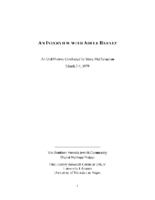Search the Special Collections and Archives Portal
Search Results
Jack Ruggles oral history interview
Identifier
Abstract
Oral history interview with Jack Ruggles Sr. conducted by Donald Parker on March 15, 1978 for the Ralph Roske Oral History Project on Early Las Vegas. In this interview, Ruggles describes moving to early Boulder City, Nevada in 1931 as a child due to his step-father's supervisory job at the Hoover (Boulder) Dam. Ruggles describes life in Boulder City and later becoming a construction worker and helping to build the Basic Magnesium Plant in Henderson, Nevada. Ruggles goes on to discuss his career and experiences as a police officer in Las Vegas, Nevada. During the discussion of his career as a police officer, Ruggles describes his participation in maintaining racial segregation in casino properties for casino owners.
Archival Collection
Rosemary Cleman (Conner) oral history interview
Identifier
Abstract
Oral history interview with Rosemary Cleman (Conner) conducted by Beatrice Owens (Gillard) on March 8, 1981 for the Ralph Roske Oral History Project on Early Las Vegas. Conner discusses moving to Las Vegas, Nevada to become a teacher for emotionally disturbed children and assisting with the creation of the Nevada Girls Training Center. Conner also discusses the segregation of the African American community. The interview concludes with Conner discussing the reemergence of mining communities in Nevada and her close interaction with Nevada governors during her career in social services.
Archival Collection
Jacqueline MacFarlane oral history interview
Identifier
Abstract
Oral history interview with Jacqueline MacFarlane conducted by Claytee D. White on February 04, 2010 for the Boyer Early Las Vegas Oral History Project. In this interview Jacqueline MacFarlane discusses her early childhood in Las Vegas, Nevada, her move to rural Nevada because of the Great Depression, her move back to Las Vegas, and meeting her husband David MacFarlane, an Air Force Cadet, at the Nellis Air force Base. She then discusses family life, Las Vegas in the 1950s and 1960s, and the various jobs she held on the Las Vegas Strip.
Archival Collection

Transcript of interview with Adele Baratz by Steve McClenachan, March 3-4, 1979
Date
Archival Collection
Description
Interview with Adele Baratz by Steve McClenachan on March 3 and 4, 1979. In this interview, Baratz talks about growing up in Las Vegas and her her schooling. She graduated from Las Vegas High School in 1944, and discusses the rationing that took place during World War II. She went to Maryland for nursing school and returned to Las Vegas in 1947. She describes some of the hotels and casinos, and tells the story of her father trading property for an automobile in 1935. She also recalls the building of Hoover Dam, swimming in local pools, and going to Mount Charleston in the winter. The interviewer asks her about travel between Las Vegas and California and the impact of Atlantic City on Las Vegas tourism. Baratz then talks about her nursing career and starting a re-certification program in 1974 and the different hospitals in the area.
Text

Transcript of interview with George Gilbert by Ruth Guidi, February 10, 1975
Date
Archival Collection
Description
On February 10, 1975, Ruth Guidi interviewed George Gilbert (born 1931 in Southgate, California) about his life in Nevada. George first talks about his education in Las Vegas and his family background. He also talks about times during World War II, the shopping facilities available to those in Las Vegas, the casinos that existed, the churches that were built, and the Helldorado parades. The two also discuss social clubs, politics, the atomic testing, environmental and social changes, the Mormon Fort, Hoover Dam, and the first movie theaters.
Text
Cashman, James, Sr., 1884-1962
James "Big Jim" Cashman was born to Benjamin Franklin Cashman and Ella Mary Stovall in Ladue, Missouri on December 16, 1884. Cashman moved to Searchlight, Nevada in 1904 and began working a variety of jobs until he opened an automobile garage in approximately 1910. Cashman later sold automobiles and operated in Searchlight until the mining boom halted around 1920. As a result, Cashman decided to move his business to the growing city of Las Vegas, Nevada. Cashman met his future wife, Leah Barker, in Las Vegas and they married in 1923.
Person

Photographs of prayer dedication of the Boulder Dam site, circa 1931
Date
Archival Collection
Description
Two views of the assembled guests present for the dedicatory prayer of the Hoover Dam construction site.
Transcribed Notes: Transcribed from the back of Photo 1: "Dedicatiary (sic) site of Boulder Dam, 1-r, 4- Mrs. Thomas, 5- Art Ham Sr., 6- Bess Pembroke (white hat), 7- Ata Ham (lt. tweed coat), 8- Nana Lightfoot, 9- Mrs. Minetti, 10- Mrs. Martin, 1st row- far right Harley Harmon." Transcribed from facsimile accompanying Photo 2: "Prayer; dedication of damsite (sic), r-1, 6- Nellie Martin, 7- Bess Pembroke, 8- "Nana" Lightfoot, 9- Roy Martin, 10- Art Ham, Sr."
Image
Betty Ham Dokter Photograph Collection
Identifier
Abstract
The Betty Ham Dokter Photographs depict the Ham Family from 1850 to 1976. The materials include photographs of the family after they moved to Las Vegas, Nevada in 1916 and document the early growth of the city. The materials also include photographs of the Colorado River, the Hoover (Boulder) Dam site before and after its construction, dinner parties, family photographs, and citizens of the Las Vegas area. The materials also include photographs of Alta Mereness Ham, Betty Ham Dokter's mother, on the set of the film Water.
Archival Collection
Nellie Bunch oral history interview
Identifier
Abstract
Oral history interview with Nellie Bunch conducted by Robin Ducharme on November 20, 1975 for the Ralph Roske Oral History Project on Early Las Vegas. Bunch first talks about her settlement into the Whitney Ranch area of Henderson, Nevada, and her knowledge about the building of Hoover (Boulder) Dam. She also talks about the early utilization of water resources from Lake Mead, early sources of power, and the early use of evaporative coolers. Bunch also speaks about her experience as a postmaster and later discusses telephone technology and the early churches of Las Vegas, Nevada.
Archival Collection
